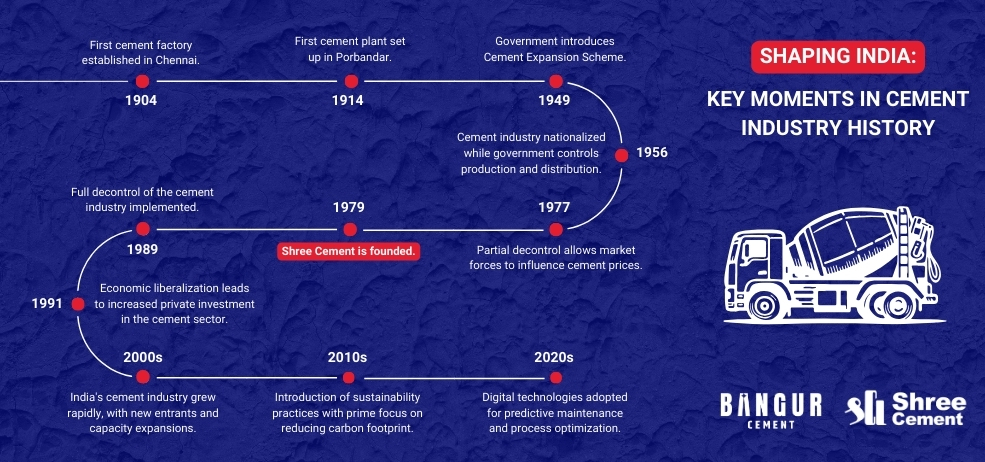The Pillar of National Development
The cement industry in India plays a crucial role in the infrastructure and economic development of the country. With its roots deeply embedded in the nation's growth story, the industry has evolved significantly with innovation, sustainability, and quality. As one of the largest manufacturers of cement globally, India's cement industry continues to thrive, driven by a commitment to excellence and a vision for a sustainable future.
A Rich Legacy of Excellence
India's cement industry has a long and storied history, dating back over a century. It began in the early 20th century with a modest production capacity, but has grown exponentially to become a global leader.
Key Milestones:
Early Beginnings: The first cement plant in India was established in 1914 in Porbandar, Gujarat.
Rapid Expansion: Post-independence, the industry saw rapid expansion to meet the infrastructure needs of a growing nation.
Global Recognition: Today, India is the second-largest cement producer in the world, contributing significantly to global supply.
The Backbone of Infrastructure Development
The cement industry is integral to India's infrastructure development, contributing to everything from residential projects to massive infrastructure endeavors like highways, bridges, and smart cities. Cement is the foundation upon which India's urban and rural landscapes are built, making the industry a key player in national growth.
Applications of Cement in India:
Residential Construction: Cement is the cornerstone of building homes, providing strength and durability.
Commercial Projects: From shopping malls to office spaces, cement is essential for creating safe, long-lasting structures.
Infrastructure Development: The industry supports major projects, including roads, highways, bridges, and airports, crucial for connectivity and economic growth.
Explore products of Bangur Cement and their construction applications here. For bulk cement order, kindly reach out to us here.
Commitment to Sustainability
Sustainability is no longer a choice but a necessity in the cement industry. Leading companies are now focused on reducing carbon footprints, optimizing resource use, and ensuring environmentally friendly practices. The shift towards green cement and energy-efficient processes reflects the industry's commitment to a sustainable future.
Sustainable Practices in the Industry:
Green Cement: Incorporating industrial by-products like fly ash and slag to reduce CO2 emissions.
Energy Efficiency: Implementing energy-efficient technologies and processes to minimize energy consumption.
Waste Management: Utilizing alternative fuels and raw materials (AFR) to reduce reliance on traditional energy sources and minimize waste.
Innovation- Driven Growth
Innovation is at the heart of the growth of the cement industry in India. From digital transformation to advanced production technologies, companies are embracing innovation to enhance quality, efficiency, and customer satisfaction.
Key Innovations:
Digital Transformation: Using AI and machine learning for predictive maintenance, quality control, and supply chain optimization.
Advanced Manufacturing Techniques: Utilizing robotics and automation to improve accuracy and reduce human error.
Product Development: Creating specialized cement products for different applications, such as ready-mix concrete and ultra-high performance concrete (UHPC).
Challenges and Opportunities Ahead
While the Indian cement industry has made significant strides, it faces challenges such as fluctuating raw material prices, stringent environmental regulations, and the need for infrastructure upgrades. However, these challenges also present opportunities for growth, innovation, and increased sustainability.
Challenges:
Environmental Regulations: Adhering to strict environmental norms requires continuous investment in cleaner technologies.
Supply Chain Management: Managing the logistics of raw materials and finished goods efficiently is crucial for maintaining competitiveness.
Opportunities:
Rural and Urban Development: As India continues to urbanize and develop its rural areas, the demand for cement will rise, presenting opportunities for growth.
Export Potential: With the right strategies, Indian cement companies can increase their presence in global markets, leveraging cost advantages and quality.
Find Out More: Learn how Bangur Cement is navigating these challenges here.
Concluding Section before CTA:
The Indian cement industry is a dynamic and essential sector, fueling the nation's growth and development. As the industry continues to innovate and adopt sustainable practices, it stands poised to meet the demands of a growing economy while contributing to a greener, more sustainable future. At Bangur Cement, the top cement company in India, we are proud to be a part of this journey, providing top-quality cement products that help build a stronger, better India.


